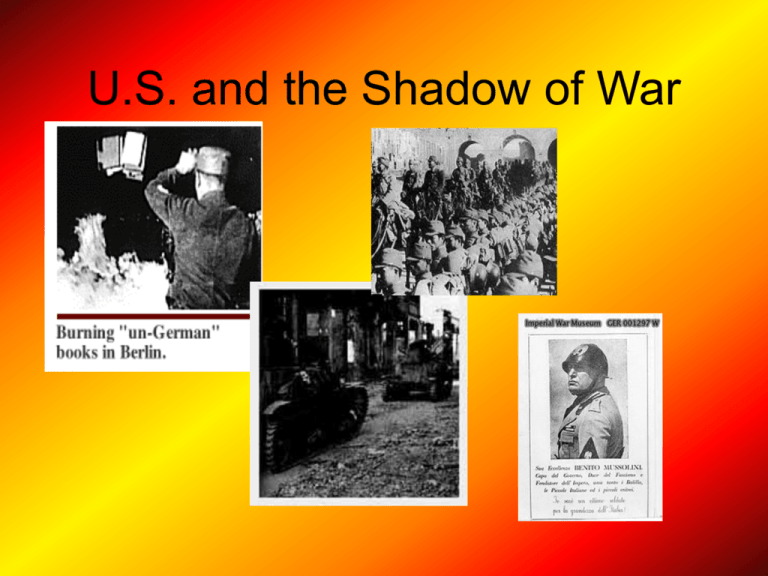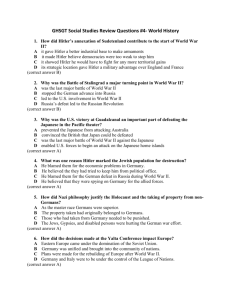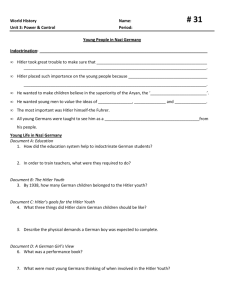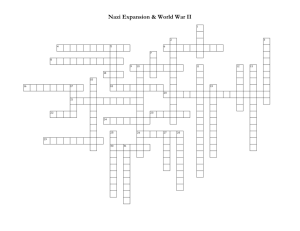Road to WW 2
advertisement

U.S. and the Shadow of War Recognition of the Soviet Union • U.S. formally recognizes the Soviet Union in 1933. • Roosevelt hoped for trade with Soviet Russia • Hoped to use the Russians as a power counterbalance between Germany in Europe and Japan in Asia Mussolini and Fascism in Italy • Fascism – an aggressive nationalism • The nation is more important than the individual • Strongly anti-Communist • Mussolini portrayed his party as the wall between Communism and the ownership of property and the Middle class. • He promised full employment Mussolini and Fascism in Italy • In 1922 leads a march on Rome to protect the nation • Conservatives get the King of italy to name Mussolini premier. • With the backing of industrialist, landowners and the Catholic Church, Mussolini takes over the government • He is called Il Duce Adolf Hitler and Germany • A strong anti-communist and admirer of Mussolini • Helped form the Nationalist Socialist Worker’s Party or Nazi Party • Led a rebellion in Munich in 1923 and tried to seize power. The power grab known as the “Beerhall Putszh” failed and Hitler was imprisoned • While in prison wrote a book called Mein Kampf. Mein Kampf • Called for unification of all German people • A master race of “blonde blue-eyed Germans” called Aryans • Lebensraum or living space – get the land from the East from the inferior Slavic people who would be enslaved. • Blaming the Jews for the world’s problems and the German loss in World War I Mein Kampf • 1925 Copy of Hitler's Mein Kampf The Rise to Power • Hitler persuaded the German government to lift its ban on the Nazi party. • In 1928, the Nazis polled just 810,000 votes in German elections; however, in 1930 after the Depression began, they polled 6 ½ million votes. • Two years later, Hitler ran for president; he lost, but received 13 ½ million votes--37 percent of all votes cast. • The Nazis had suddenly become the single largest party in the German parliament. • In January 1933, Germany's president named Hitler chancellor. The German elite thought they could control Hitler • A year and a half later Hitler was Germany's dictator. Hitler’s Germany • Hitler's government outlawed labor unions, imposed newspaper censorship, and decreed that the Nazis would constitute Germany's only political party. • The regime established a secret police force, the Gestapo, to suppress all opposition and required all children, 10 years and older, to join youth organizations designed to indoctrinate Nazi beliefs. • By 1935, Hitler had transformed Germany into a fascist state. The government exercised total control over all political, economic, and cultural activities. Hitler’s Germany • Replacing crucifixes in some German houses were Hitler Corners which were suppose to bring good luck to families • The Volkswagen was created by Ferdinand Porsche so that all Germans could afford automobiles • Rest farms create so women could breed the perfect Aryan child. Nazi Germany Nazi Germany • Anti-Semitism was an integral part of Hitler's political program. • The 1935 Nuremberg Laws – forbade intermarriages, – restricted property rights, – barred Jews from the civil service, the universities, and all professional and managerial occupations. Kristallnacht • On the night of November 9, 1938--a night now known as Kristallnacht (the night of the broken glass)— – the Nazis imprisoned more than 20,000 Jews in concentration camps – destroyed more than 200 synagogues and 7,500 Jewish businesses Militarist Take Control of Japan • Economics in Japan collapsed because Japan had to import the majority of their resources • Japanese military officers blamed the problems on corrupt politicians • Believed that democracy was un-Japanese and bad for the country Japan Invades Manchuria • Japanese officers invade resource rich Manchuria without government permission • When the Japanese Prime Minister tried to negotiate a peace, he was assassinated. • Japan viewed themselves as the future of Asia Japanese Attack Manchuria (1931) League of Nations condemned the action. Japan leaves the League. Hoover wanted no part in an American military action in the Far East. Hoover-Stimpson Doctrine (1932) 5 US would not recognize any territorial acquisitions that were achieved by force. 5 Japan was infuriated because the US had conquered new territories a few decades earlier. 5 Japan bombed Shanghai in 1932 massive casualties. Nye Committee Hearings (1934-1936) 5 The Nye Committee I investigated the charge that WW I was needless and the US entered so munitions owners could make big profits [“merchants of death.”] 5 The Committee did charge Senator Gerald P. Nye [R-ND] that bankers wanted war to protect their loans & arms manufacturers to make money. 5 Claimed that Wilson had provoked Germany by sailing in to warring nations’ waters. 5 Resulted in Congress passing several Neutrality Acts. Ludlow Amendment (1938) 5 A proposed amendment to the Constitution that called for a national referendum on any declaration of war by Congress. 5 Introduced several Congressman Louis Ludlow [D-IN] times by Congressman Ludlow. 5 Never actually passed. Neutrality Acts: 1935, 1936, 1937 When the President proclaimed the existence of a foreign war, certain restrictions would automatically go into effect: Prohibited sales of arms to belligerent nations. Prohibited loans and credits to belligerent nations. Forbade Americans to travel on vessels of nations at war [in contrast to WW I]. Non-military goods must be purchased on a “cash-andcarry” basis pay when goods are picked up. Banned involvement in the Spanish Civil War. This limited the options of the President in a crisis. America in the 1930s declined to build up its forces! US Neutrality Rome – Berlin – Tokyo Axis • 1936 - Hitler and Mussolini signed a treaty pledging cooperation on international issues • 1936 – Japan aligned itself with Germany and Italy with the Anti-Comintern Pact • Became known as the Axis Powers Spanish Civil War (1936-1939) The American “Lincoln Brigade” Spanish Civil War • The Civil War devastated Spain from July 17,1936 to April 1, 1939 – ending with the victory of the rebels and the founding of a dictatorship led by the General Francisco Franco • supported by Fascist, army officers, landowners and the Catholic Church • A preliminary of World War 2 – Germany and Italy supported Franco while the Soviets supported the Coalition of Republicans Japan Moves 1937 – the Japanese attack China from Manchuria The Japanese armed forces were surprised by the level of Chinese resistance that preceded the fall of Shanghai and took out their frustration on the civilians and soldiers who surrendered the city of Nanking in December of 1937. Realistic estimates indicate that 300,000 Chinese civilians and soldiers were killed and that Japanese soldiers raped tens of thousands of the city’s women. Panay Incident (1937) 5 December 12, 1937. 5 Japan bombed USS Panay gunboat & three Standard Oil tankers on the Yangtze River. 5 The river was an international waterway. 5 Japan was testing US resolve! 5 Japan apologized, paid US an indemnity, and promised no further attacks. 5 Most Americans were satisfied with the apology. 5 Results Japanese interpreted US tone as a license for further aggression against US interests. The SS (MS) St. Louis • German conceived plan at propaganda that would show the world they had a “Jewish problem” just like Germany did. • The ship was refused entry to the USA, Cuba, Canada • Allowed to offload some passengers in UK, Belgium, France Italian Aggression • One of Mussolini's goals was to create an Italian empire in North Africa. • In 1912 and 1913, Italy had conquered Libya. • In 1935, he provoked war with Ethiopia, conquering the country in eight months. Germany Strikes 1935, he publicly announced that he was building an air force and a 550,000-man army. He also declared that Germany would have a peacetime draft, a clear violation of the Treaty of Versailles. 1936, German troops re-occupied the Rhineland, the German-speaking region between the Rhine River and France. France and Great Britain did not oppose Hitler's bold advance, for they believed (or wanted to believe) the Rhineland would satisfy his ambitions. Germany Strikes Intent on reuniting all German-speaking peoples of Europe under the "Third Reich," Hitler annexed Austria in 1938 and imprisoned the country's chancellor. Once again, the British and the French acquiesced, hoping Austria would be Hitler's last stop. Later that year, he demanded the Sudentenland, the German-speaking region of western Czechoslovakia. Germany Strikes In September 1938, Edouard Daladier, the premier of France, and Neville Chamberlain, Britain's prime minister, met with Hitler in Munich, Germany, to determine whether he had further designs on Europe. Fearing they could not count on each other to use force, British and French leaders eagerly accepted Hitler's promises not to seek additional territory in Europe. Germany Strikes Upon arriving in England, Chamberlain told his anxious countrymen that he had returned with an agreement that guaranteed "peace in our time." In less than a year, Munich would become synonymous with shameful appeasement, and Chamberlain would be vilified for believing Hitler's lies Germany Strikes In August 1939, Germany and the Soviet Union signed a non-aggression treaty. In exchange for the pact, Hitler agreed to grant the Soviet Union a sphere of influence over eastern Poland, Estonia, Latvia, Finland, and Bessarabia (northeastern Romania), while Stalin approved Germany's designs on western Poland and Lithuania. With his eastern front protected from attack, Hitler was now prepared for war. World War 2 Begins At daybreak on September 1, 1939, mechanized German forces broke across the Polish border, while German bombers and fighters attacked Polish railroads from the air. On September 17, Russia attacked Poland from the east. Within three weeks, Poland was overrun. World War 2 Begins New military strategy known as blitzkrieg (lightning war). Blitzkrieg stressed speed, force, and surprise and closely coordinating air power and mechanized ground forces. Britain and France declared war on Germany on September 3, 1939, two days after the German invasion began. But the two countries did little while Poland fell. 1939 Neutrality Act In response to Germany’s invasion of Poland. FDR persuades Congress in special session to allow the US to aid European democracies in a limited way: The US could sell weapons to the European democracies on a “cash-and-carry” basis. FDR was authorized to proclaim danger zones which US ships and citizens could not enter. Results of the 1939 Neutrality Act: Aggressors could not send ships to buy US munitions. The US economy improved as European demands for war goods helped bring the country out of the 1937-38 recession. America becomes the “Arsenal of Democracy.” 1940 France moved its troops to its famous Maginot Line, a supposedly invincible line of defensive fortification built to protect France's eastern border. No fighting took place in late 1939 and 1940, leading people to call this a "phony war." Hitler captured Denmark and Norway The capture of Norway forces Chamberlain to resign and he’s replaced by Winston Churchill 1940 Winston Churchill, who (since 1932) had been warning people about the danger Hitler posed Churchill told the British people that he had nothing to offer them but "blood, toil, tears, and sweat" in their fight to resist foreign aggression France May 1940, Hitler began his assault on Western Europe. He outflanked France's Maginot Line by attacking Belgium, Luxembourg, and the Netherlands before driving his forces into France British expeditionary force rushed across the English Channel to try to stop the German offensive. However, a German tank thrust forced the British to retreat to the French seaport of Dunkirk. With the British force nearly surrounded, Hitler had a chance to crush his opponents. But Britain's Royal Air Force held off German bombers long enough to allow a flotilla of yachts, ferries, and fishing boat to evacuate 338,000 allied troops across the English Channel. Anglo-U.S. Friendship British forces had been driven from the continent. Worse yet, they had been forced to leave their weapons and tanks behind. Britain turned to the United States for help. President Roosevelt responded to the Dunkirk disaster by ordering U.S. military arsenals to send all available war materiel to Britain to replace the lost equipment. The Fall of France During World War I, France held out against the Germans for four years. This time, French resistance lasted two weeks. Germany began its assault on France on June 5; a German troop entered Paris on June 14; and on June 22, a new French government, made up of pro-German sympathizers, was set up at Vichy. In just six weeks, Germany had conquered most of continental Europe. The Battle of Britain Hitler sought to occupy Britain. Convinced that Britain would negotiate with him (in order to keep control of its empire), Hitler decided against an immediate invasion. Churchill, however, refused to bargain. Defiantly, he told his people that he would resist any German assault: "We shall fight on the beaches...we shall fight in the streets...we shall never surrender." The Battle of Britain Hitler was furious. First, he unleashed German submarines against British shipping. Then, in July, he sent his air force, the Luftwaffe, to destroy Britain from the air. At the time the assault began, the Royal Air Force (RAF) had just 704 serviceable planes, while Germany had 2,682 bombers and fighters ready for action. Throughout July and August, the Luftwaffe attacked airfields and radar stationed on Britain's southern and eastern coast The Battle of Britain Next, in September Hitler shifted strategy and began to bomb civilian targets in London. These air raids, known as the blitz, continued through the fall and winter. In May 1941, the blitz ended. While outnumbered, the RAF had won the Battle of Britain. Churchill expressed his nation's gratitude with the famous words: "Never in the field of human conflict was so much owed by so many to so few." Hitler Lies!!!! Hitler shifted strategy and invaded the Soviet Union. The attack, which began on June 22, 1941, violated the German-Soviet nonaggression pact. Hitler's goal was to seize Soviet food and oil and to capture slave labor for Germany. At first, the Nazi war machine seemed invincible; by fall, Hitler's armies had overrun the grain fields of Ukraine and were approaching Moscow and Leningrad. But instead of pressing ahead toward Moscow, as his generals advised, Hitler decided to seize Leningrad and occupy the Ukraine. By the time he was ready to advance on Moscow, temperatures had plunged to 40 degrees below zero. In the frigid cold, German troops suffered frostbite, and their equipment broke down. “America First” Committee Charles Lindbergh “Lend-Lease” Act (1941) Great Britain.........................$31 billion Soviet Union...........................$11 billion France......................................$ 3 billion China.......................................$1.5 billion Other European.................$500 million South America...................$400 million The amount totaled: $48,601,365,000 Pearl Harbor








